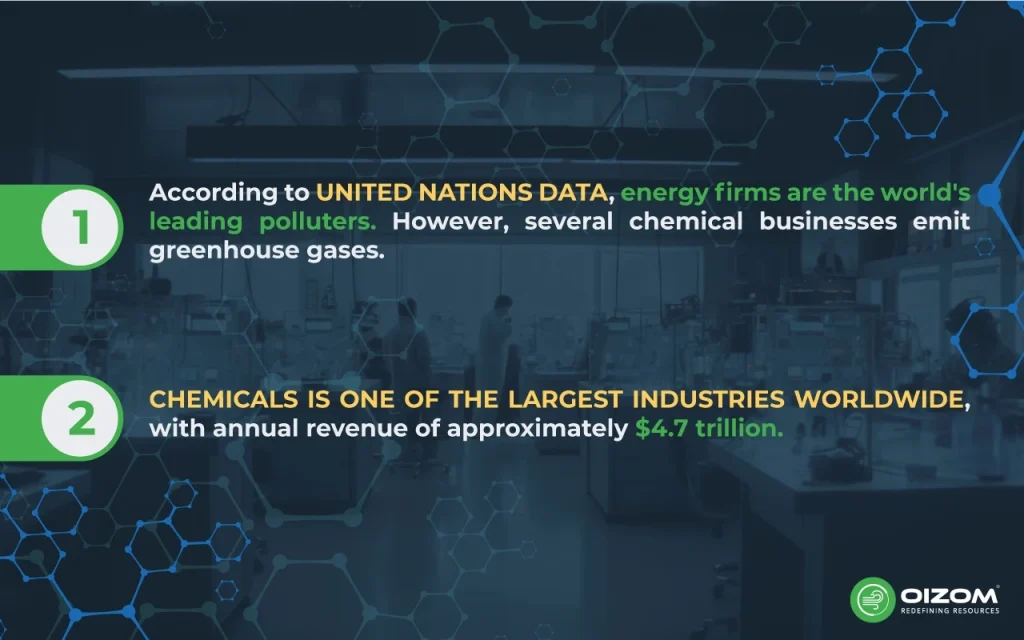The global carbon footprint is an individual or organization’s total greenhouse gas emissions, measured in metric tonnes of CO2 equivalent. According to United Nations data, energy firms are the world’s leading polluters. However, several chemical businesses emit greenhouse gases. The chemical sector, crucial to world economies, contributes significantly to carbon emissions and climate change. This sector, which manufactures basics such as plastics, fertilizers, and pharmaceuticals, relies considerably on fossil fuels, resulting in a significant carbon impact.
Embracing creative ideas is critical for the chemical industry’s move to sustainable practices. This involves minimizing reliance on fossil fuels, improving energy efficiency, and using renewable raw resources. Such a transition is more than just compliance or reaching sustainability standards; it is a fundamental shift required for the industry’s long-term viability and the health of the environment. In this blog, we will delve into the critical role of the chemical industry in global carbon emissions, process optimization, and efficiency with CCUS, as well as how the chemical industry can achieve net zero emissions by 2050.
Current CO2 Emissions in the Chemical Industry

Chemical manufacturers play an essential role in the global economy by producing raw materials for various goods and industries. However, chemical manufacture is a highly energy-intensive process that frequently generates significant carbon emissions. Chemicals is one of the largest industries worldwide, with annual revenue of approximately $4.7 trillion. The CO2 emissions are released into the atmosphere by producing chemicals such as plastics, fertilizers, and pharmaceuticals. Chemical manufacturing involves several processes, including reactions between raw materials and using energy sources like natural gas, coal, or oil. The combustion of these fuels emits carbon dioxide, as well as other greenhouse gases like methane and nitrous oxide, into the environment.
In addition to direct emissions from energy use, chemical manufacturing can generate indirect emissions from raw material production, transportation, and waste product disposal. Carbon emissions from chemical manufacturing contribute to climate change and global warming, so reducing these emissions is essential to addressing the industry’s environmental effects.
Measures to take to reduce carbon emissions in the chemical industry
A targeted approach based on process optimization, energy efficiency, and technical innovation is required to reduce carbon emissions in the chemical sector considerably. Implementing energy-saving technology such as modern heat recovery systems and optimizing process heating can significantly reduce energy usage and dependency on fossil fuels. Emphasizing waste reduction through green chemistry concepts and closed-loop processes reduces environmental impact while increasing resource efficiency. Additionally, the integration of digitization and automation is critical. Advanced process control systems, real-time monitoring, and AI algorithms for predictive maintenance can help improve production efficiency and minimize energy use.
Process Optimization and Efficiency
Adopting energy-saving technologies is a fundamental step for the chemical industry to enhance its efficiency and reduce emissions. Innovations such as advanced heat recovery systems, energy-efficient reactors, and optimized process heating can drastically lower the energy demand of chemical processes. Implementing state-of-the-art catalytic processes that require less energy for the synthesis of chemicals also plays a crucial role. Moreover, transitioning to renewable energy sources, such as solar, wind, and biomass, for process heat and electricity further diminishes the reliance on fossil fuels, cutting greenhouse gas emissions.
Energy-saving technologies
Chemical manufacturers can implement energy-efficient solutions to lower the energy required to produce chemicals. This can be accomplished through a variety of methods. It entails process optimization, waste heat recovery, and updating equipment to more energy-efficient models. Furthermore, energy efficiency techniques can save money while also reducing carbon emissions.
Waste reduction
Waste reduction is another critical measure. By adopting principles of green chemistry, such as minimizing the use of hazardous substances and designing efficient processes, the industry can reduce waste at the source. Implementing closed-loop processes and recycling waste streams minimizes environmental impact and cuts costs associated with waste disposal and raw material procurement. Moreover, investing in technologies that convert waste into valuable products or energy ensures that resources are utilized efficiently, contributing to a circular economy.
Digitalization and automation
Integrating digitalization and automation within the chemical industry offers substantial opportunities to reduce carbon emissions. Advanced process control (APC) systems and real-time monitoring, such as Oizom Polludrone, can help monitor real-time data with cutting-edge technologies. The Polludrone system ensures its workers and nearby residents breathe clean air within safe limits, safeguarding their health and well-being. Its robust and compact design enables reliable operation even in harsh weather conditions, requiring minimal space for installation. It can keep track of the historical data and trends of the air pollutants emitted by chemical manufacturing companies. It can optimize production processes, enhancing efficiency and reducing energy consumption. Digital tools and AI-driven algorithms enable predictive maintenance, minimizing downtime and energy wastage.
Renewable Energy Transition
One of the most effective strategies to minimize carbon emissions in the chemical manufacturing sector is to switch to renewable energy sources like solar, wind, and hydropower. Renewable energy sources can be used to power manufacturing operations, reducing the need for fossil fuels and lowering carbon emissions. Furthermore, chemical factories can install on-site renewable energy systems to lessen grid dependency and reduce carbon footprint.
Increased use of renewables
The chemical industry’s transition towards sustainability significantly hinges on the increased use of renewables, with bioenergy, green hydrogen, and energy storage solutions at the forefront of this transformation.
Bioenergy and green hydrogen
Bioenergy, derived from biomass, presents a renewable option to replace fossil fuels in producing heat, power, and even raw materials for chemical processes. Assuming sustainable biomass sourcing, its carbon-neutral nature is a key player in reducing greenhouse gas emissions. Green hydrogen, produced through water electrolysis using renewable energy sources, stands out as a promising alternative for high-temperature heat processes and as a feedstock in chemical manufacturing. Its adoption can revolutionize the industry by providing a clean, sustainable energy carrier that significantly cuts carbon emissions.
Energy storage solutions
The variability of renewable energy sources like wind and solar necessitates robust energy storage solutions to ensure a reliable energy supply for the chemical industry. Technologies such as batteries, thermal storage, and power-to-gas systems enable the storage of excess renewable energy, making it available during demand peaks or when renewable generation is low. This enhances the energy efficiency and stability of chemical operations and allows for greater integration of renewables into the industry’s energy mix.
Sustainable Feedstocks
Adopting sustainable feedstocks is a pivotal strategy for the chemical industry to reduce its carbon footprint and embrace circular economy principles. This shift involves using bio-based chemicals, direct air CO2 capture, and recycled waste. By incorporating sustainable materials into their manufacturing processes, chemical firms can lower their carbon footprint. This can involve using biodegradable and non-toxic materials and incorporating recycled resources into manufacturing. Furthermore, sustainable materials can help to minimize carbon emissions by lowering the demand for new raw materials and trash.
Bio-based chemicals
The transition to bio-based chemicals involves replacing traditional petrochemical feedstocks with renewable biological materials. These bio-based feedstocks, derived from plants, microorganisms, and agricultural waste, offer a sustainable alternative for producing various chemicals and materials. This helps reduce dependence on fossil fuels and minimizes greenhouse gas emissions associated with chemical production. Bio-based chemicals can be designed to be biodegradable, reducing the environmental impact of end products and promoting a more sustainable lifecycle.
Direct air CO2 capture
An innovative approach to sustainable feedstocks is directly capturing CO2 from the atmosphere, which can be used as a chemical synthesis raw material. This technology helps mitigate climate change by reducing atmospheric CO2 levels and provides a renewable carbon source for producing fuels, plastics, and other chemicals. Direct air capture and renewable energy sources can revolutionize the chemical industry by making it a net carbon sink rather than a source of emissions.
Biomass and recycled waste
Utilizing biomass and recycled waste as feedstocks is another sustainable pathway. Biomass, including agricultural residues and non-food crops, can be converted into valuable chemicals and energy, offering a renewable and often low-cost alternative to conventional feedstocks. Similarly, recycling waste materials, from plastics to industrial by-products, into new chemicals reduces the need for virgin materials and tackles the growing waste management problem. These practices are fundamental to building a circular economy, where waste is minimized and resources are reused and recycled.
Carbon Capture, Utilization, and Storage (CCUS)
Chemical industries can use CCS technologies to capture and store underground carbon dioxide emissions from their industrial operations. This strategy can help minimize the quantity of carbon dioxide released into the atmosphere, thus mitigating the consequences of climate change.
Circular Economy Strategies:
Chemical producers may utilize circular economy models to reduce waste and maximize resource utilization. This strategy can include reusing materials and products, recycling waste, and recovering energy from waste. By embracing circular economy concepts, chemical firms can lower their carbon impact.
Finally, chemical manufacturers can lower their carbon footprint by implementing renewable energy, energy efficiency, sustainable materials, CCS technology, and circular economy models. By employing these techniques, chemical makers may help to create a more sustainable future and lessen the consequences of climate change.
How can the chemicals industry achieve Net Zero emissions by 2050?
To achieve Net Zero emissions by 2050, the chemicals industry must embrace a holistic approach, focusing on renewable energy, efficiency, sustainable feedstocks, carbon capture, and circular economy practices. Transitioning to renewable energy sources like wind, solar, and bioenergy is essential to cut reliance on fossil fuels. Enhancing energy efficiency through technological innovations and process optimizations can significantly lower energy consumption and emissions. Adopting bio-based chemicals and materials reduces the carbon footprint of raw materials and supports the development of eco-friendly products. Implementing carbon capture, utilization, and storage (CCUS) technologies will be crucial in offsetting emissions from industrial activities. Moreover, promoting a circular economy by maximizing recycling and reusing materials within the industry helps reduce the demand for virgin resources and minimizes waste. Together, these strategies can propel the chemicals industry toward its goal of having net zero emissions by 2050.
Conclusion
Finally, innovative concepts and sustainable practices are helping the chemical industry reduce carbon emissions. Key among these are using renewable energy sources to replace fossil fuels, introducing energy-saving technology, and optimizing processes to improve efficiency. The transition to bio-based chemicals and sustainable feedstocks, such as biomass and recycled waste, are key steps in reducing the industry’s carbon footprint. Furthermore, deploying carbon capture, utilization, and storage (CCUS) technology and efforts to promote a circular economy through recycling and reusing materials are critical to achieving Net Zero emissions by 2050. By implementing these techniques, the chemical industry may dramatically reduce its environmental effects and align with global sustainability goals, contributing to the larger fight against climate change and paving the path for a more sustainable and resilient future.
FAQs
Reducing carbon emissions is vital for chemical manufacturers to lessen climate change impacts, comply with environmental regulations, meet consumer sustainability demands, and improve operational efficiency and competitiveness.
Achieving zero carbon emissions involves shifting to renewable energy, enhancing energy efficiency, using sustainable materials, implementing carbon capture technologies, and promoting a circular economy. Collaborative efforts across policy, technology, and consumer behavior are essential.
The primary cause of carbon emissions is the combustion of fossil fuels for electricity, heat, and transportation, contributing significantly to global greenhouse gas levels and climate change.






